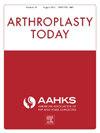2 型糖尿病患者使用胰高血糖素样肽-1 受体激动剂与全膝关节置换术后并发症增加无关
IF 1.5
Q3 ORTHOPEDICS
引用次数: 0
摘要
背景胰高血糖素样肽-1(GLP-1)激动剂已成为一种强有力的糖尿病辅助治疗药物;然而,它对全膝关节置换术(TKA)术后效果的影响却不甚了解。本研究旨在比较服用 GLP-1 激动剂和未服用 GLP-1 激动剂的 2 型糖尿病患者在 TKA 术后出现并发症的风险。方法利用大型国家数据库对 2016 年至 2021 年间接受初级 TKA 手术的 34,696 名 2 型糖尿病患者进行了回顾性研究。采用倾向得分匹配法,将使用 GLP-1 激动剂的患者与对照组按 1:1 的比例进行匹配(各为 2388 人)。结果对照组延长住院时间(≥3 天)的几率更高(几率比 1.29,P < .001)。然而,90 天后的手术并发症发生率(包括手术部位感染和假体关节感染)并无显著差异。同样,内科并发症也无差异。结论这项研究发现,在接受 TKA 手术的糖尿病患者中,GLP-1 促效剂的使用与内科或外科并发症发生率的增加无关,而且与术后住院时间延长率的降低有关。鉴于使用 GLP-1 激动剂的患者有可能增加血糖控制和减轻体重,因此需要更多的数据来界定 GLP-1 激动剂在糖尿病患者关节置换术前的术前优化中的潜在作用,以最大限度地减少术后并发症。本文章由计算机程序翻译,如有差异,请以英文原文为准。
Glucagon-Like Peptide-1 Receptor Agonist Use is Not Associated With Increased Complications After Total Knee Arthroplasty in Patients With Type-2 Diabetes
Background
Glucagon-like peptide-1 (GLP-1) agonists have emerged as a powerful diabetic treatment adjunct; however, its effects on outcomes following total knee arthroplasty (TKA) are not well known. The purpose of this study was to compare the risk of complications after TKA in patients with type-2 diabetes who were on GLP-1 agonists with those who were not.
Methods
In total, 34,696 type 2 diabetes patients undergoing primary TKA between 2016 and 2021 were retrospectively reviewed utilizing a large national database. Propensity score matching was employed to match patients on GLP-1 agonists to controls at a 1:1 ratio (n = 2388 each). Multivariable logistic regression was utilized to examine 90-day and 1-year TKA outcomes between cohorts.
Results
Controls had higher odds of extended hospital stays (≥3 days) (odds ratio 1.29, P < .001). However, surgical complication rates at 90-days including surgical site infection and prosthetic joint infection were not significantly different. Similarly, no differences were seen in medical complications. There were also no significant differences in rates of all-cause revision TKA and aseptic revision TKA at 1 year postoperatively.
Conclusions
This study found that GLP-1 agonist use was not associated with increased medical or surgical complication rates in patients with diabetes undergoing TKA and was associated with lower rates of extended hospital stays after surgery. Given the potential for increased glycemic control and weight loss in patients using GLP-1 agonists, more data are needed to delineate the potential role of GLP-1 agonists in preoperative optimization of patients with diabetes prior to joint arthroplasty to minimize postoperative complications.
求助全文
通过发布文献求助,成功后即可免费获取论文全文。
去求助
来源期刊

Arthroplasty Today
Medicine-Surgery
CiteScore
2.90
自引率
0.00%
发文量
258
审稿时长
40 weeks
期刊介绍:
Arthroplasty Today is a companion journal to the Journal of Arthroplasty. The journal Arthroplasty Today brings together the clinical and scientific foundations for joint replacement of the hip and knee in an open-access, online format. Arthroplasty Today solicits manuscripts of the highest quality from all areas of scientific endeavor that relate to joint replacement or the treatment of its complications, including those dealing with patient outcomes, economic and policy issues, prosthetic design, biomechanics, biomaterials, and biologic response to arthroplasty. The journal focuses on case reports. It is the purpose of Arthroplasty Today to present material to practicing orthopaedic surgeons that will keep them abreast of developments in the field, prove useful in the care of patients, and aid in understanding the scientific foundation of this subspecialty area of joint replacement. The international members of the Editorial Board provide a worldwide perspective for the journal''s area of interest. Their participation ensures that each issue of Arthroplasty Today provides the reader with timely, peer-reviewed articles of the highest quality.
 求助内容:
求助内容: 应助结果提醒方式:
应助结果提醒方式:


